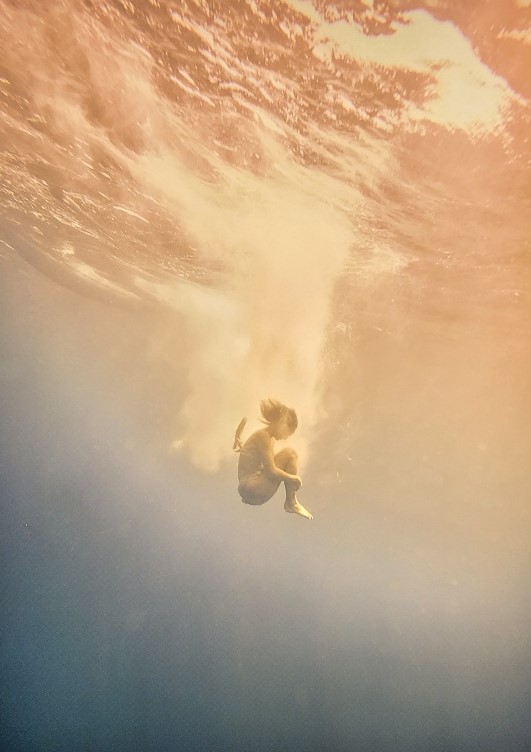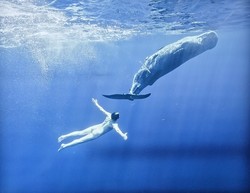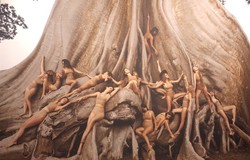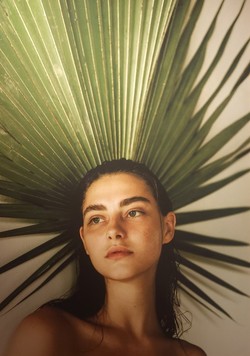How can we define the emotions we feel when facing the vast and beautiful nature? Many modern people feel trapped in our concrete jungle, or are out of breath by hurriedly moving their footsteps on cold asphalt roads. Born in Kazakhstan, the environmentalist and photographer Natalie Karpushenko places us back on the warm, vast land of the Earth through her heart-warming photographs that focus on the beauty of the Earth and life. Let's go to the exhibition <Photographs by Natalie Karpushenko> to share her calm and wide eyesight, which affectionately accepts that humans and nature are not opposites, but that humans are just a part of nature.

Ocean Breath

“There are common things between animals and us in nature. Animals are always born naked without wearing anything and that’s same with us.” ‘The Ocean Breath’ section talks about the preservation of the marine world with the main theme being the ocean and the whales full of vitality. Especially, the photos of naked people swimming next to a huge whale prove that all living things are most beautiful in their pristine state. The work ‘Falling Deep’ contains the image of a woman in a crouching position surrounded by air bubbles in the sea as if she had just dived in. Although the name of the photo is ‘falling deeply’, if you observe the photo for a long time, it seems that she is not falling but rather being embraced by the sea at the moment her body meets the ocean. Even though it is the air represented by the numerous bubbles in the picture that humans need to survive, the viewers start to imagine that they can live even without air when they look at the perfect sea. Photos listed under the name of ‘Marine Dance’, contain fleeting images of humans, whales, and dolphins swimming together just below the surface of the water as if they are dancing. Looking at the photos, watchers can have a strange experience of processing the rough surface of the water at the top as the ground, and the calm water below the shore as the sky. The image of the sea beneath the constantly moving waves that Karpushenko's cameras capture might be the world of freedom that human beings most longed for.
Angel


The second section, ‘Angel’, conveys the comfort humans feel in the water through the images of the sea, sky, and wings. In this section, fantasy beyond the nature you actually see is maximized by bringing various mythical images that many people may have imagined while watching nature in their childhood. The model of ‘Angel Julie’, Julie who is a psychological counselor, dynamically moves between the sea and the sky with wings made of dried leaves. In all works depicting angels, the audience can see the artist's efforts to capture the natural beauty of humans as much as nature. The artwork brings a thought that maybe angels, who are thought of as sacred, may be hidden inside all of us. The work ‘Water Pixies’ contains innocent images of joyful people who look comfortable in the sea as if they were born in deep water. Next to the photo, the words of an American novelist Anais Nin is written. “I must be a mermaid, I have no fear of depths and a great fear of shallow living”. In the photo, women who are not afraid of the depths are shown, almost looking like mermaids. Perhaps Anais Nin's words are not just imaginary, but a fact, since all creatures including humans originally came from the sea.
Rising Woman


The third section, ‘Rising Woman’, gives a deep resonance with the combination of nature and humans. Our lives are now sustained out of the sea, but all human beings first existed in the womb of a woman, and this section intuitively shows the origin and vitality of humans through the connection between water and women. The work ‘Rebirth of Woman’ depicts various women lying freely next to rocks near low water by the shore. The work shows how the curves of a woman's body resemble the various round curves of rocks caused by waves, showing the union of nature and humans. The work ‘Rising Woman’, which has the same name as the section, shows women leaning comfortably on the roots and trunks of a huge old tree, wearing minimal clothes the similar color as the tree. In her former works, nature in Karpushenko's photos is portrayed more as an overwhelming figure rather than a warm and friendly existence. Nevertheless, the audience looking at the photos feel stable and comfortable because the people reflected in the photos are accepting nature as it exists, not just as a background, and are even melting into it. In her work ‘Human needs Human’, several women in the water can be seen reaching out and approaching each other. Humans need each other and that means we are all connected. Everything on Earth revolves around this world through water. At the same time, humans also circulate the world through each other and through women. Women themselves exist as single oceans.
Wild Breath


The section ‘Wild Breath’ shows the intimate connection between animals and humans. The art works which show a huge green halo created by the leaves of the jungle are portraying the Earth as a higher element in that it depicts divine images through the sources of nature. A naked woman who is holding wild chickens on her shoulders, smiles brightly in a picture. In the work ‘Lisa and the Cheetah’, a cheetah often known as a ferocious beast, is licking Lisa peacefully. Lisa, who only sat still and waited for the cheetah's movements, expressed that she felt the sweetest greeting she would ever remember the moment the cheetah sniffed and licked her. Cheetahs are an endangered species with only about 7,000animals left worldwide due to habitat loss caused by human developments or illegal trade. In the end, Karpushenko's pure and precious photos convey warmth through the image of humans interacting with nature affectionately, but at the same time, they also make us think about the situation of humans killing the breath of nature. When the strength of wild animals and the triviality of humans in the great nature are contrasted, the audience can ironically focus on the reality where the lives of animals are subject to the cruelty of humans.
Natalie Karpushenko, who believes that true beauty can only be captured when one sees everything as it is, shows the primordial appearance of nature and humans unadorned and untouched through her photographs. Looking at the endless sea, lush trees, and vast forests containing footprints of wild animals captured by her sight, we experience overwhelming beauty. Also, although the theme itself is nature, the most important element of Karpushenko''s works are certainly human. Through the naked and free people in her pictures, we can feel her love for humans who all become an element connecting the universe just by the act of being born.
Dates: 2022.12.23 ~ 2023.06.30
Hours: 10:00~19:00 (Entrance is allowed until 18:00)
*Closed on every Monday
Place: Groundseesaw Seochon
Ticket Prices: All Ages 15,000won
Contact: 1522-1796

